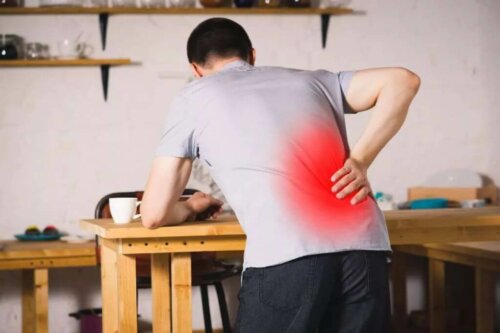Uses and Side Effects of Comfrey


Written and verified by the doctor Leonardo Biolatto
Comfrey (Symphytum officinale) is a perennial plant that people have used for various medicinal purposes throughout history. It belongs to the Boraginaceae family and grows in the form of a shrub in countries in Europe, Asia, and North America.
In traditional medicine, people usually use the roots and leaves of the plant. In fact, in countries like Japan, it’s known as knitbone and is used in the case of muscle sprains, contusions, and superficial wounds. What does the evidence say? Keep reading to find out all about it.
Common uses of comfrey
First of all, it’s important to note that comfrey is a plant that you should use with caution. Although some studies support its medicinal properties, they have also warned about the presence of toxic products, such as pyrrolizidine alkaloids, which can harm your health.
In fact, some countries have banned the sale of oral comfrey preparations and it hasn’t been approved by the Food and Drug Administration (FDA). Therefore, it’s best to avoid its consumption completely and only use it topically, in specific cases.
Back pain
On its own, researchers haven’t shown comfrey root to be effective against back pain. However, in a study published in Phytotherapy Research, creams that had comfrey root were helpful in relieving upper and lower back pain.
Specifically, it seems that applying this product to the affected area for five days reduces the feeling of pain and tension. However, we still need further studies to corroborate these effects.

Read also: Arnica and Coconut Oil Ointment to Treat Lower Back Pain
Sprains
Preliminary evidence suggests that topical use of comfrey extract ointments can improve mobility and decrease pain in case of sprains. In fact, the effects of its application for two weeks have been compared with those of diclofenac gel.
Osteoarthritis
In research published in the Journal of Chiropractic Medicine, applying active formulations of topical comfrey was helpful against the symptoms of knee osteoarthritis. Specifically, the ointment combined:
- Comfrey extract
- Tannic acid
- Aloe vera gel
- Eucalyptus oil
- Frankincense oil
Over a period of 6 to 12 weeks, people who used this remedy 3 times a day experienced a decrease in stiffness and pain, even more than those who used a placebo cream.
Comfrey side effects
Currently, due to the findings on its toxic compounds, we don’t recommend oral comfrey remedies. Chemicals, like pyrrolizidine alkaloids, can cause liver damage, lung problems, and cancer, according to the evidence.
Now, although specialists consider it to be safe for topical use in small amounts, occasionally, some research has suggested that some of its toxic agents can be absorbed through the skin. For this reason, we don’t recommend using it on open wounds. Also, you shouldn’t use it in large quantities or for more than 6 weeks.
Right now, it’s completely contraindicated for:
- Women who are pregnant or lactating
- Burns and serious injuries
- Liver disease
- Treatments with acetaminophen, amiodarone, fluconazole, itraconazole, among others

Be sure to check out: Learn All About the Benefits of Dandelion
What is a safe dose?
Coinciding with the research we mentioned, there are several standard doses that can be considered safe when using comfrey. In any case, it’s always important to follow the recommendations of the manufacturer, pharmacist, or doctor.
- In the case of back pain, you can apply 4 grams of ointment with 35% comfrey root extract 3 times a day, 5 days a week.
- For sprains, 2 grams of ointment with 35% comfrey extract are enough, 4 times a day, for 8 days.
- As a complement for symptoms of osteoarthritis, the dose is 2 grams of ointment with 35% extract of comfrey root, 3 times a day, for 3 weeks. You can also use a 3.5 gram dose of cream with comfrey extract, tannic acid, aloe vera gel, eucalyptus oil, and frankincense oil. You can use this last option 3 times a day, for up to 12 weeks.
If you experience comfrey overdose, seek immediate medical attention. Likewise, it’s essential to consult your doctor if you have any disease and want to use products with comfrey extract.
All cited sources were thoroughly reviewed by our team to ensure their quality, reliability, currency, and validity. The bibliography of this article was considered reliable and of academic or scientific accuracy.
- Salehi B, Sharopov F, Boyunegmez Tumer T, et al. Symphytum Species: A Comprehensive Review on Chemical Composition, Food Applications and Phytopharmacology. Molecules. 2019;24(12):2272. Published 2019 Jun 18. doi:10.3390/molecules24122272
-
Pabst, H., Schaefer, A., Staiger, C., Junker-Samek, M., & Predel, H.-G. (2012). Combination of Comfrey Root Extract Plus Methyl Nicotinate in Patients with Conditions of Acute Upper or Low Back Pain: A Multicentre Randomised Controlled Trial. Phytotherapy Research, 27(6), 811–817. https://doi.org/10.1002/ptr.4790
-
Frost, R., MacPherson, H., & O’Meara, S. (2013). A critical scoping review of external uses of comfrey (Symphytum spp.). Complementary Therapies in Medicine, 21(6), 724–745. https://doi.org/10.1016/j.ctim.2013.09.009
- Smith DB, Jacobson BH. Effect of a blend of comfrey root extract (Symphytum officinale L.) and tannic acid creams in the treatment of osteoarthritis of the knee: randomized, placebo-controlled, double-blind, multiclinical trials. J Chiropr Med. 2011;10(3):147‐156. doi:10.1016/j.jcm.2011.01.003
- Moreira R, Pereira DM, Valentão P, Andrade PB. Pyrrolizidine Alkaloids: Chemistry, Pharmacology, Toxicology and Food Safety. Int J Mol Sci. 2018;19(6):1668. Published 2018 Jun 5. doi:10.3390/ijms19061668
This text is provided for informational purposes only and does not replace consultation with a professional. If in doubt, consult your specialist.








